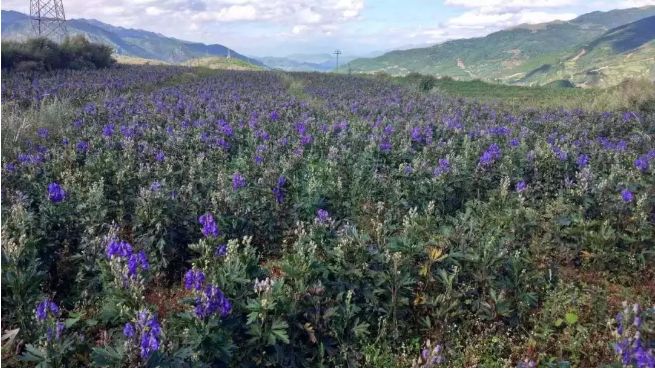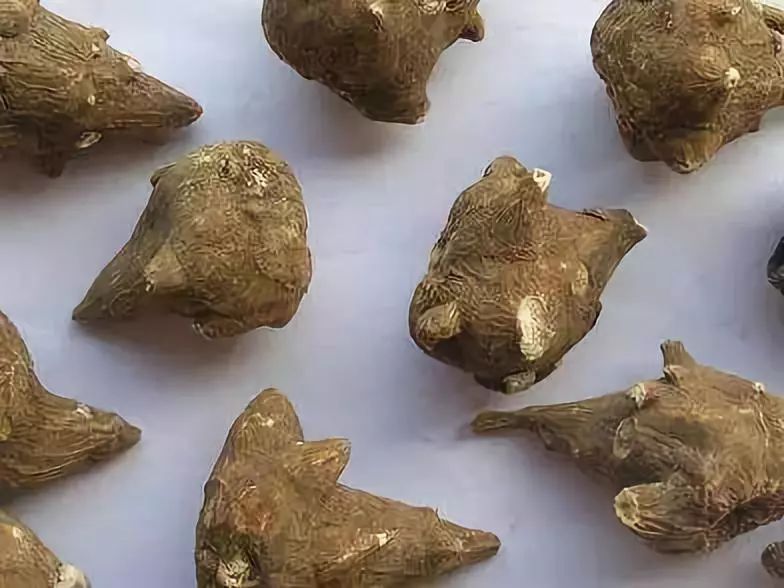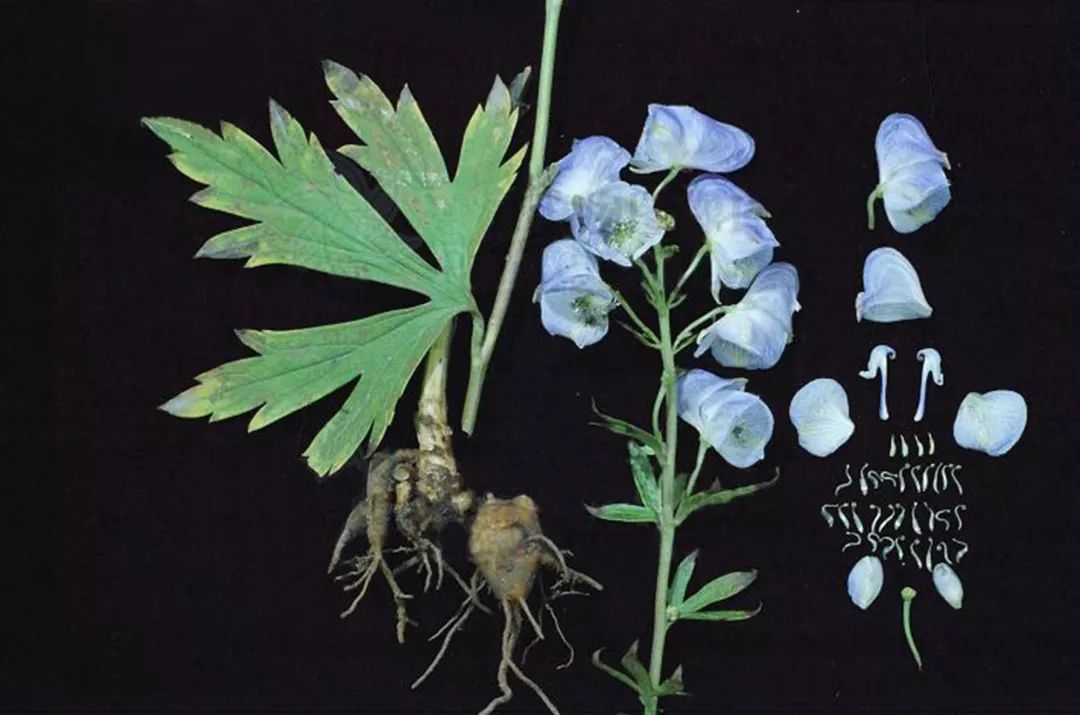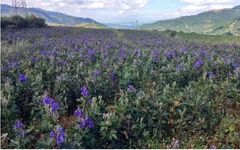
Aconite Base
Aconite (Fu Zi) is known as one of the “Four Essentials of Medicine” in TCM, with significant efficacy. The “Shang Han Lun” records 21 formulas containing Aconite, while the “Jin Gui Yao Lue” includes 13, and the “Zhou Hou Fang” lists 60. However, the dosage of Aconite has always been a topic of debate, with some asserting that “Aconite is highly toxic and must be used in small amounts,” while others believe that “Aconite is the king of all medicines” and should be used in larger quantities. The “Pharmacopoeia of the People’s Republic of China” (referred to as the “Pharmacopoeia”) lists this product as a processed product of the root of the Aconitum plant, which is pungent, sweet, very hot, and toxic. It enters the Heart, Kidney, and Spleen meridians, and has the functions of reviving yang, supplementing fire to assist yang, dispelling cold, and alleviating pain. Clinically, it is mainly used for symptoms such as yang collapse, cold limbs, weak pulse, insufficient heart yang, chest obstruction and heart pain, cold and deficient vomiting and diarrhea, cold abdominal pain, kidney yang deficiency, impotence, external invasion of yang deficiency, yin cold edema, and cold dampness obstructing pain, with a dosage of 3 to 15 grams. In actual clinical practice, the dosage of Aconite often exceeds the amount specified in the “Pharmacopoeia,” which poses significant challenges for clinical medication, making it difficult to achieve a “legal” yet reasonable use. This article further discusses the dosage of Aconite.
01
Toxicity of Aconite
Modern pharmacological studies indicate that the main components of Aconite are alkaloids, with the highest content and toxicity being in the diester alkaloids, which exhibit cardiac, neurological, and renal toxicity. The toxicological mechanism primarily involves initially exciting the body’s nerves, followed by a paralyzing effect. The toxic dose is 0.2 mg, and 3 to 5 mg can be lethal. Symptoms of poisoning mainly include arrhythmia, nausea, vomiting, difficulty breathing, and numbness in the limbs.
02
Usage of Aconite
Accurate Differentiation
In clinical use, Aconite must strictly adhere to the disease mechanism and accurately differentiate syndromes. Zhang Zhongjing primarily used Aconite for Shaoyin syndrome, with the main indication being “weak and fine pulse, but desiring to sleep.” Renowned late Qing physician Zheng Qinan believed that “all yang deficiency symptoms can use Aconite, without needing to wait for the disease to be at least Shaoyin, as long as the tongue is bluish, the mouth is pale and not thirsty, and the pulse is spiritless, the person is calm,” which serves as a clinical indication for use. The Huogong school emphasizes the integration of the four examinations: ① observing the complexion, whether there is mental fatigue or pale complexion; ② observing the physique, whether the body is slightly overweight and prefers stillness; ③ checking for thirst, whether there is a desire for hot drinks; ④ checking urination and defecation, whether the urine is clear and long, and whether the stool is clear and loose; ⑤ observing the tongue and pulse, whether the tongue is pale with a white coating, and the pulse is deep, slow, and thin. Wu Peiheng from the Huogong school established “cold syndrome” as a standard and further expanded the scope of “cold syndrome,” believing that Aconite can be used for both exterior and interior cold as long as clinical symptoms such as “drowsiness, fear of cold, preference for warmth, shortness of breath, and fatigue” are present, which is also one of the main indications for Aconite use. Liu Duzhou emphasized that “Aconite is a great pungent and hot substance, which easily injures yin,” thus all yang syndromes, heat syndromes, fire syndromes, and yin deficiency with blood deficiency should be used cautiously or avoided, and it can only be used when symptoms present as “cold body and limbs, tongue moist and smooth, and pulse weak and powerless.” Professor Huang Huang from Nanjing University of Chinese Medicine summarized the symptoms for Aconite as “mental fatigue, drowsiness, fear of cold, and cold limbs, especially in the lower limbs,” emphasizing the need for syndrome differentiation in the application process, and avoiding use in cases of excess heat syndrome or false cold with true heat. Of course, in clinical practice, in addition to differentiating Aconite symptoms, one should also consider various differences in patient constitution, age, and other factors.
Processing
Historical herbal texts have required strict processing of Aconite, from the fire processing method in the Han dynasty to modern methods such as licorice processing, steaming, and black bean processing. Common processing methods include “salt processing,” “ginger processing,” and “steaming.” Processed Aconite can be categorized into different types such as “salt Aconite,” “black shun slices,” and “white Aconite.” Different processing methods have varying effects on the toxicity and efficacy of Aconite; for example, the toxicity of peeled Aconite can be reduced by nearly 50%. Studies have shown that Aconite and Wu Tou can retain efficacy while reducing toxicity after processing. However, one should also be cautious of excessive processing, as overly pursuing medication safety can reduce the efficacy of Aconite. For instance, after complete hydrolysis of aconitine, it can form aconine, which significantly reduces toxicity but also almost completely loses its notable cardiotonic effect.
Compatibility
Aconite is rarely used alone. The “Bencao Jing Jizhu” states: “In common prescriptions, Aconite must be paired with licorice, ginseng, and ginger to counteract its toxicity.” Zhang Zhongjing often combined Aconite with ginseng, ginger, or dried ginger, and licorice to enhance efficacy and reduce toxicity, such as in the Gan Jiang Fu Zi Tang, Si Ni Tang, and Gan Cao Fu Zi Tang. Generally, the ratio of licorice to Aconite is often 1:2 or 2:3, while the ratio of ginger or dried ginger to Aconite is often 1:1 or 1:2. This compatibility is based on certain evidence; studies have shown that when Aconite is combined with licorice, the content of its ester alkaloids can be reduced by about 79%, and the effective components of licorice, such as flavonoids and isoliquiritigenin, have significant effects against arrhythmias caused by aconitine. Additionally, when dried ginger is decocted with Aconite, the content of aconitine in the decoction is reduced by about 41% compared to when Aconite is decocted alone, and the total toxic alkaloid content is reduced by about 73%. High-performance liquid chromatography has shown that compared to decocting Chuan Wu alone, the content of monoester alkaloids in the Aconite decoction combined with black beans and Fang Feng is reduced by about 74% and 70%, respectively. Besides the aforementioned combinations, Aconite can also be combined with other herbs to enhance efficacy and reduce toxicity, such as with Bai Shao, Huang Qi, Jing Mi, Wu Mei, and honey, but care should be taken not to use it simultaneously with incompatible herbs like Ban Xia, Gua Lou, Bei Mu, Bai Ji, and Bai Lian.

Decoction
Aconitine can hydrolyze into various alkaloids under heating conditions, significantly reducing its toxicity. Modern physician Fan Zhonglin from Sichuan often decocts Aconite for about 1.5 hours to reduce toxicity and ensure medication safety; Wu Peiheng uses a larger dosage of Aconite, emphasizing prolonged decoction, first using strong fire for rapid boiling, then slow fire to add other herbs for a total decoction time of about 3 hours. Renowned physician Li Ke from Shanxi also emphasizes slow decoction for about 2 hours, but in critical situations, he uses strong fire for rapid decoction, such as in the Po Ge Jiu Xin Tang to save lives in critical moments. Wu Peiheng’s disciple Wu Rongzu proposed that the focus of decocting Aconite is not on thorough processing but on thorough boiling, reflecting the importance of decoction for the safe use of Aconite. However, He Liqing and others pointed out in “On Whether Aconite Must Be Pre-Decoction” that when the dosage of Aconite does not exceed that of ginger and licorice, it can be decocted together with other herbs without needing pre-decoction. Modern research also indicates that after 0.5 hours of decocting cooked Aconite, the content of diester alkaloids essentially disappears, and after 1 hour of decoction, the content of monoester alkaloids and total alkaloids reaches a peak, thus the optimal decoction time is considered to be around 1 hour.
Administration
Considering that different patients may have varying sensitivities to Aconite, it is recommended to first test for oral numbness before taking the medication, and to take a small amount initially, with further doses only if there is no effect, typically three doses per day. For critical conditions, it is generally taken in a single dose, such as in the Gan Jiang Fu Zi Tang for treating the precursors of collapse. When taking warm decoctions containing Aconite, hot consumption is most effective, but if there is excessive yin cold leading to immediate vomiting after taking, the decoction can be cooled first, or combined with pig bile or children’s urine to prevent rejection of the medication. During the administration of Aconite formulas, it is advisable to avoid cold and cool foods or medicines to prevent reducing the efficacy, and it is also recommended to avoid rich, greasy, and spicy foods. Of course, it is important to avoid long-term high-dose administration of Aconite decoctions, aiming for quick results, achieving therapeutic goals within three to five doses, and if continued use is necessary, gradually reduce the dosage, and after a week of continuous use, it is best to stop for 2 to 3 days to prevent drug accumulation and toxicity.

03
Dosage of Aconite
Zhang Zhongjing not only accumulated the experiences of predecessors in the use of Aconite but also had his unique insights, believing that raw Aconite is mainly used for reviving yang and rescuing collapse, while processed Aconite is primarily used for warming yang and dispelling cold, with a typical dosage of 1 to 3 pieces. Different literature presents significant variations in the dosage of Aconite in the “Shang Han Lun.” Based on modern collections of wild Aconite, the average weight of one piece is about 15 grams, with larger pieces weighing up to 31 grams, so it can be inferred that the dosage of Aconite in the “Shang Han Lun” generally ranges from 15 to 90 grams. The usage of Aconite in the “Shang Han Lun” is considered one of the more classic and detailed accounts in historical herbal texts, and the Aconite formulas used today are largely derived from the “Shang Han Lun.” Therefore, the dosage should be referenced against the classic formulas; if one uses Zhang Zhongjing’s formula but does not adhere to Zhang Zhongjing’s dosage, the effect will naturally be suboptimal. It is particularly noteworthy that wild Aconite grows slowly in suitable natural environments and has a long growth cycle, while modern cultivated Aconite differs significantly in toxicity and efficacy.
The Fu Yang school has broadened the clinical application of Aconite to some extent, emphasizing the yang energy within the body and advocating for supplementing fire to assist yang as one of its characteristics. In modern times, renowned physician Zhu Weiju uses smaller dosages, but in treating collapse and shock, he often exceeds the modern “Pharmacopoeia” dosage, reaching up to 30 grams. Wu Peiheng and Fan Zhonglin use larger dosages of Aconite, often exceeding 60 grams per dose. Li Ke believes that small doses of Aconite can regulate the body and treat some chronic diseases, but in critical situations, small doses have no significant effect, and he asserts that large doses of Aconite can rescue the dying yang and restore the collapsing yin. Therefore, based on the Si Ni Tang, he created the Po Ge Jiu Xin Tang, where the dosage of processed Aconite generally ranges from 30 to 120 grams, and in critical cases, raw Aconite is used directly. This formula has shown significant efficacy in treating various critical conditions over long-term use. Although the Fu Yang school is adept at using Aconite to treat various difficult and critical conditions, large doses do not equate to abuse; clinical use should still be combined with syndrome differentiation and not merely pursue dosage.
Experts in classic formulas often exceed the “Pharmacopoeia” dosage when using Aconite; for instance, modern Lingnan physician Chen Botan often uses up to 30 grams; classic formula practitioner Feng Shilun often uses 20 to 30 grams in treating bi syndrome; and Master of National Medicine Zhu Liangchun believes that in non-critical situations, the dosage of Aconite should be gradually increased, typically to around 30 grams. Most modern physicians are relatively conservative in their use of Aconite, and even in cases of accurate syndrome differentiation, they are hesitant to exceed the recommended dosage or use too small a dose, which can lead to inadequate therapeutic effects. This is also an important reason for the suboptimal efficacy of TCM in certain acute and critical conditions.
04
Poisoning Rescue
In the event of Aconite poisoning, the following methods can be employed for treatment: ① Traditional Chinese medicine treatment, commonly using mung bean and licorice soup, such as 120 grams of mung beans and 60 grams of licorice, decocted and consumed; or adding honeysuckle, coptis, and honey to the mung bean and licorice soup for decoction, which can also be combined with acupuncture and other treatment methods. ② In Western medicine, the main drugs used include atropine, dopamine, and other emergency medications; for arrhythmias, amiodarone can be used, and even defibrillation may be necessary. Additionally, supportive treatments such as inducing vomiting, gastric lavage, intravenous fluids, and vitamin C supplementation may be employed, and a combination of TCM and Western medicine treatment can also be utilized.
In clinical practice, the use of large doses of Aconite inevitably raises concerns about its toxic side effects. However, whether poisoning occurs is not only related to the drug dosage but also crucially depends on how it is used, as the saying goes, “All medicines have some toxicity.” TCM theory holds that all drugs possess certain “biases,” which were historically referred to as “toxicity.” In fact, in clinical practice, there are no universally good medicines without biases, nor are there diseases without biases; there are appropriate medicines for appropriate syndromes, and when syndrome differentiation, compatibility, and administration are correct, one can utilize their “biases.” Renowned Qing dynasty physician Wang Mengying stated, “When used appropriately, nitre and sulfur can be considered tonics; when used inappropriately, ginseng and atractylodes are no different from arsenic.” When we understand Aconite in this way, we will no longer simply fear its toxic side effects.
The dosage of Aconite specified in the “Pharmacopoeia” is relatively small and has certain limitations, which may be the result of analyzing only the decoction of Aconite alone. A more comprehensive consideration of TCM’s syndrome differentiation, compatibility, and processing factors is necessary. Therefore, it is recommended to re-evaluate the dosage of Aconite in the “Pharmacopoeia,” allowing for adjustments based on syndrome differentiation, clinical situations, and severity of illness, or categorizing Aconite into small, medium, and large doses for different situations, or distinguishing between routine and critical doses. This approach can fully leverage the clinical efficacy of TCM while ensuring legal and reasonable medication use. (Shi Zhongliang, Lu Haining, Zhang Zhanlin, Guangzhou University of Chinese Medicine, Guo Liheng, Second Affiliated Hospital of Guangzhou University of Chinese Medicine)
Source: Official account of the China Journal of Traditional Chinese Medicine(This article is excerpted from the “Journal of Traditional Chinese Medicine” 2018, Issue 23)
This WeChat account is the official account of the Chinese Association of Traditional Chinese Medicine, email: [email protected]



